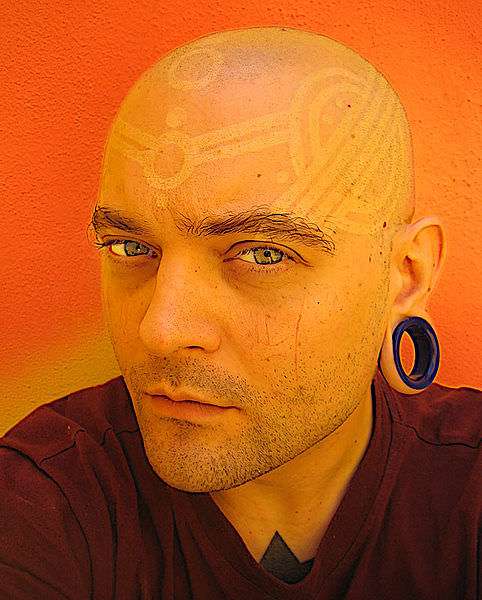RIP Shannon Larratt and Joe Weider, Two Huge Pioneers of Self-Ownership

Two pioneers of self-ownership and unregulated body modification died this month. Joe Weider, the fitness-publishing mogul who brought professional bodybuilding from the sideshow tent to the main stage (discovering Arnold Schwarzenegger and creating a magazine empire along the way) died March 23. He was 93. Shannon Larratt, founder of BMEzine, the Internet's largest crowdsourced guide to "extreme" body modification, died on March 15 at age 39. If you've ever crushed on a punkette with full sleeves and gauged earlobes or shot a front double biceps pose in the bathroom mirror, you have Weider and Larratt to thank.
Today, Weider is best known for his magazines (Muscle & Fitness, Flex, Shape) and his annual bodybuilding and figure competition, the Mr. Olympia. But his history with the sport goes back to the very beginning. When Weider, along with his younger brother Ben, founded the International Federation of Body Builders in 1946, many people--even weightlifters like York Barbell founder Bob Hoffman--thought muscularity for its own sake was obscene. Nevertheless Weider stuck with his focus on size, symmetry, and definition, turning bodybuilding into a full-fledged sport. He and Ben, who died in 2008, also managed to popularize it behind the Iron Curtain, traveling to the Soviet Union multiple times between 1952 and 1988 to advocate for the recognition of bodybuilding as a sport and for the inclusion of Soviet athletes in the IFBB. Today, muscles are mainstream and the USSR is dead.
Weider also had a history of fighting the U.S. government. A charitable interpretation of his clashes with the Feds is that Weider and other supplement advocates were moving too fast for the FDA's liking. A less charitable interpretation is that Weider mingled junk science and the real thing, promising not only that protein could make your muscles grow (which is true), but that his brand of protein could make your muscles grow a pound a day (un-uh).

As for Larratt: While many of the body modification procedures he popularized predated him, it wasn't until he started BMEzine (NSFW) in 1994 that practitioners from around the world had a central hub for discussing their techniques. BMEZine is now a massive clearing house for knowledge about how to modify the human body. Participants run the gamut from tattoo and piercing junkies to people who have drastically transformed everything from their faces to their genitals. If I had to guess, I'd say at least half the procedures and techniques covered on BMEzine--branding, suspension, and scarification, to name three not-unusual mods here in the states--are illegal to perform. Yet people perform them anyway, and thanks to the crowdsourced knowledge available on BMEzine, they know how to do so with relative safety and precision.
Like Weider, Larratt also was in direct conflict with authority, and his interaction ended him. In 2010 Larratt was diagnosed with tubular aggregate myopathy. The disease apparently caused him significant pain, which his doctors in Canada refused to aggressively treat, thinking that he was addicted to pain medication. In his suicide note, Larratt wrote
I do believe that there were fundamental shortcomings in the way both my condition and my pain was treated, and that the last few years could have been much more pleasant if the pain had been more aggressively managed. I believe this was in part because of the prejudice of multiple doctors due to my appearance causing them to stereotype me as drug seeking (and the simple reality is that it can be hard to tell, and we are so cruel as to prefer to "punish" the sick than to "reward" the mentally ill). I wish there was some way to make those doctors understand the cruelty they enacted. A patient should have the right to a pain free life, even if that comes with some risk.
….
The last medical thing I want to mention is that I want to strongly advocate for "right to die" legislation. Canada currently has no such thing. It is my strong believe that if I had known that there was a "safe", pain-free way for me to go at a time of my choosing, hopefully at home surrouded by love, it would have brought me not just enormous peace, but I believe would have given me strength to fight this even longer than I have. As Isaac Asimov said, "No decent human being would allow an animal to suffer without putting it out of its misery. It is only to human beings that human beings are so cruel as to allow them to live on in pain, in hopelessness, in living death, without moving a muscle to help them." And this is how I have felt for a long time now, trapped in this nightmarish prison of pain. Losing my motor skills hasn't been fun either, but the pain is the worst part. After writing that I can't help but think of Keats. I really do hope people will one day have as much right to control their deaths as to control their lives — it is in many ways, the fundamental human right, even more fundamental than thought and self-expression.
The thread linking Weider and Larratt is a shared vision of self-ownership that is in permanent conflict with the state and the public health establishment. In that sense, the mass monsters Weider championed--guys like Ronnie Coleman and Jay Cutler--are not so different than the branded, scarred, and pierced-up misfits who commune at BMEzine.com.


Show Comments (15)